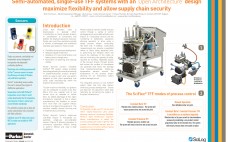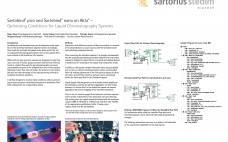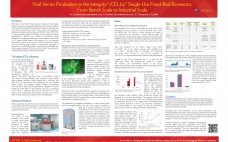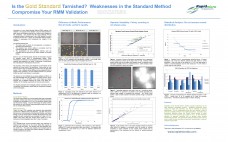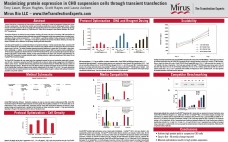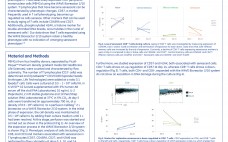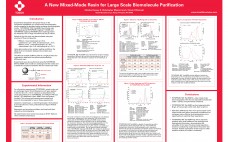Cross flow filtration used in bioprocesses is typically either microfiltration to clarify process streams or ultrafiltration to concentrate and diafilter the biopharmaceutical molecule. Single-use cross flow operations provide a number of advantages over traditional stainless steel systems. These include: • Flexibility during process development • Reduced capital investment • Avoidance of cross contamination and faster product change overs • Elimination of steaming and cleaning utilities Parker domnick hunter’s innovative SciFlex® TFF system utilizes propriety technology allowing the sterile processing of…
Year of Publication
Sartobind® pico and Sartobind® nano on Akta® – Optimizing Conditions for Liquid Chromatography Systems
Sartobind pico and Sartobind nano are the laboratory-scale mem-bers of the Sartobind membrane adsorber family. Accordingly, their small size and high throughput make them perfect for use on automated chromatography systems such as the popular Akta series offered by GE Healthcare Life Sciences.While both the pico and nano capsules are designed for high flow rates, the array of valves, pumps, monitors and the flow restrictor found in a typical flow path for gel chromatography can cause unacceptable pressures at the…
Platform Purification of a Domain Antibody
Monoclonal antibodies (MAbs) are very successful for treatment of several different cancers and tumors. However, the low tissue penetration has led to the development of smaller sized biopharmaceuticals (Ab fragments) such as Fabs, single chain Fv (scFv) and domain antibodies (Dabs). These molecules lack the Fc part of the antibody making a platform purification approach using Protein A impossible. However, with the introduction of the Protein L based affinity chromatography media (Capto™ L) new possibilities are introduced for capture of…
Viral Vector Production in the Integrity® iCELLis® Disposable Fixed-bed Bioreactor from Bench-scale to Industrial Scale
Recombinant viruses (e.g. lentivirus and adeno-associated-virus) can be used as human gene therapy vectors. They are mainly produced in adherent cell cultures (e.g. HEK293T, A549, VERO) in Roller Bottles or multiple-tray-stacks using either transient transfection or infection strategies. Therefore, the Integrity® iCELLis® (ATMI LifeSciences) line of bioreactors offers a new production alternative with stronger process controls and ease of scale-up. The iCELLis bioreactor is designed for adherent cell culture applications. Cells grow on microfibers carriers packed in a fixed-bed…
Is the Gold Standard Tarnished? Weaknesses in the Standard Method Compromise Your RMM Validation
Introduction of a new Rapid Microbial Method (RMM) requires a full validation. The purpose of the validation is to prove that equivalent or better results are obtained using the new method when compared to the compendia. One assumes that the result obtained with the compendial method is absolute and is the “Gold Standard” by which to compare the new test. In reality, the compendial method exhibits a number of weaknesses that compromise the integrity of the validation. The standard requires…
Cookie Cutter Proteolysis: Achieving Reproducible, Efficient Digestions for Proteomic Workflows
Cookie Cutter Proteolysis: Achieving Reproducible, Efficient Digestions for Proteomic Workflows  Protein sample preparation workflows for mass spectrometric analysis that involve proteolysis are often labor-intensive, time consuming and user dependent. These workflows often involve digestion, solid phase extraction, drying, and re-suspension prior to reversed phase separation into the mass spectrometer. The introduction of variability at many of these steps hinders discovery initiatives as well as the ability to convert these discoveries into viable assays.  Recently, an automated protein digestion…
Maximizing Protein Expression in CHO Suspension Cells Through Transient Transfection
Transient transfection in mammalian cell lines provides an avenue for researchers to bridge the development bottleneck and shorten the time to usable protein. The method also maintains post translational modifications crucial for biotherapeutic function. Chinese Hamster Ovary (CHO) suspension cells are especially suited for high yield production of recombinant proteins, despite being refractory to commonly used transfection methods (e.g. 25kDa linear PEI). Mirus Bio has developed a more effective alternative, the TransIT-PRO® Transfection Kit. Transfection efficiencies are affected by many…
T Cells Expanded in the WAVE Bioreactor™ 2/10 System Maintain a Healthy Phenotype
T cell immunotherapy often requires the expansion of a small select starting population in vitro. To achieve therapeutic doses, this population is required to undergo multiple and rapid rounds of replication. Rapid T cell expansion raises the possibility of inducing senescence or an aged phenotype, both of which are detrimental to the recipient patient. The WAVE BioreactorTM System is often used for the final expansion phase before patient infusion and we have analysed the aging characteristics of T cells that…
Transfer of Hepatic Progenitor Stem Cell Culture Process from Multitray Stacks to the Integrity® Xpansion™ Multiplate Bioreactor
Scale-up a stem cell process may be challenging: small variations in physicochemical parameters (surface characteristics, pH and dissolved oxygen) can heavily impact stem cell growth and behavior. The Integrity® Xpansion™ multiplate bioreactors have been designed to enable an easy transfer from multiple-tray stacks process by offering the same cell growth environment: stacked hydrophylized polystyrene plates in a compact and closed system (from 10 to 200 plates per bioreactor equivalent respectively to 6120cm² and 122400cm²). As there is no headspace between…
A New Mixed-Mode Resin for Large Scale Biomolecule Purification
Chromatographic resins with high capacities and selectivities differing from those seen with traditional hydrophobic interaction and ion exchange media are now in demand. Mixed-mode chromatography media is an alternative. Some mixed-mode resins combine both traditional hydrophobic interaction and ion exchange media. This poster introduces TOYOPEARL® MX-Trp-650M, a high-capacity weak cation mixed-mode resin for the purification of biomolecules. The polymethacrylic base bead was chemically modified with the amino acid tryptophan which combines a weak cationic group with a hydrophobic functional group.…

